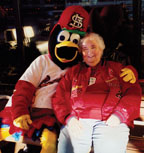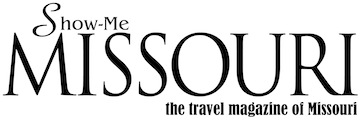
For more than 10 years, Kristen Lokemen was a staff writer and travel specialist for Show-Me Missouri. Over the summer of 2001 she assisted in conducting a tour of the Lewis and Clark Trail from Missouri to the Oregon coast and subsequently penned an 11-part series that ran through the bicentennial observance of the expedition's kickoff. She would eventually lead numerous other tours along that same path, sharing her enthusiasm with hundreds of travelers.
Sadly, Kris died on May 26, 2018. Of all the stories that Kris wrote for Show-Me Missouri, none stand out more than her series on Lewis and Clark's Corps of Discovery. Over the next two weeks, we will run the series in its entirety.
Corps of Discovery: The Journey Begins
The genius of Thomas Jefferson was that he was always curious, always expanding his knowledge, always ahead of his time. However, he seldom dined alone. Sharing Jefferson’s table during his first years in the White House was his private secretary, a 24-year-old fellow Virginian named Meriwether Lewis.
A passion for the west and a vision of a United States that stretched from one ocean to another had inspired Jefferson to try to mount expeditions in the past. Those attempts had failed, but now Jefferson was president. Lewis shared in Jefferson’s zeal for exploration. He had been west (which then was still east of the Mississippi River), fighting in the Indian wars. Lewis loved to ramble and was delighted when in 1802 Jefferson chose him to lead an expedition to the Pacific Ocean.
The need for such a venture was precipitated in part by the transfer of Louisiana from Spain back to France. Jefferson recognized the strategic importance of New Orleans and attempted to buy it from Napoleon. Much to his surprise, the French emperor, busy waging war with Russia and in need of cash, agreed to sell the entire Louisiana territory to the United States for $15,000,000—or three cents an acre. Meriwether Lewis would now be leading an expedition that would educate him and Jefferson on what the country had just bought.
To prepare for his trip, Lewis studied the sciences with Jefferson and went to Philadelphia to learn about astronomy and medicine. Dr. Benjamin Rush was Lewis’ medical advisor and helped stock the expedition with his famed “thunderclapper” pills, which Dr. Rush claimed would cure nearly any ailment.
For a partner in this enterprise, Lewis looked west to a man who had been his captain in the army. William Clark was also Virginia-born and the brother of General George Rogers Clark. While Lewis and Clark had not served together long, they had come to respect each other, and Clark happily accepted Lewis’ invitation to join him on the trip.
Through the summer of 1803, Lewis gathered supplies—rifles, provisions, medicines, gifts for the Indians they would encounter, instruments to chart their progress, barrels of whiskey to reward the men after a hard day’s work. The munificent sum of $2,500 had been appropriated by Congress to fund the expedition. Lewis would later be given the equivalent of a blank check for additional expenses.
The young captain also oversaw the building of the keelboat, a 55-foot craft that would be sailed, towed, pushed and pulled up the Missouri as far as Fort Mandan. After many delays, the boat was finally completed on August 31, 1803. Within hours, Lewis and his initial crew were headed down the Ohio River in the keelboat and a pirogue, a large flat-bottomed rowboat.
Water levels on the Ohio had fallen precipitously low that summer. At times the water was as low as six inches, so the men often had to get out and lift the keelboat over sandbars. In Wheeling, they picked up rifles and ammunition, which had been transported overland, and Lewis bought another pirogue to carry the added goods.
On October 15, six weeks after departing Pittsburgh, Lewis arrived in Clarksville, Kentucky to meet up with his partner. William Clark was four years older than Meriwether Lewis. Both men were about six feet tall and athletic. Clark was the more outgoing of the two, while Lewis suffered from mental depressions that ran in his family.
Lewis and Clark used the next two weeks to look over volunteers for the expedition. The men selected had to be both physically and mentally strong, able to handle the rigors of years in the wilderness, away from civilization. Charles Floyd and Nathaniel Pryor were chosen as sergeants. Clark also brought with him his slave named York.
Near the confluence of the Ohio and Mississippi, Lewis hired frontiersman George Drouillard, a man who would prove invaluable to the expedition for his abilities as a hunter, scout and interpreter. He was also a man whose name Lewis would never learn to spell, as illustrated in Lewis’ writings.
At the mouth of the Ohio, Lewis put into practice what he had learned about measuring latitude and longitude. He gave instructions to Clark, who would be the expedition’s master mapmaker. By Lewis’ side at all times was his Newfoundland dog, Seaman.
The men headed up the Mississippi on November 20, 1803, and they would travel upstream for most of the next two years. Moving the boats against the current for the first time was undoubtedly a deciding factor in the leaders’ decision to expand the size of their party. It would definitely take more hands to get up the Missouri.
At Cape Girardeau, then a post controlled by the Spanish, Lewis dined with Louis Lorimier, the post commandant, and his Shawnee wife. Upriver, Lewis climbed Tower Rock and measured its height at 92 feet. According to his journal, Lewis had “a most beautiful and commanding view” of the area that would become Missouri and Illinois.
Clark was in command of the crew when they landed at Ste. Genevieve, which at the time had a population as large as St. Louis. He also stopped at the remains of Fort de Chartres on the Illinois side of the river. Lewis had gone ahead to find recruits and supplies.
The boats eventually landed on the eastern side of the Mississippi, across from St. Louis, and Clark waited for Lewis to join them. The Spanish, who still controlled St. Louis and all of Louisiana, had refused the crew permission to winter in Missouri, so Clark took the men upriver another 18 miles. By Wood River, on a point of land across from the mouth of the Missouri, Lewis and Clark established what became known as Camp Wood or Camp Dubois. There the men would spend the winter that would form them into the Corps of Discovery.
P.O. Box 53
Kennett, Missouri 63857
Toll-Free: (888) 751-6334
Local: 573-888-1100
Email: info@showmemissouri.net
